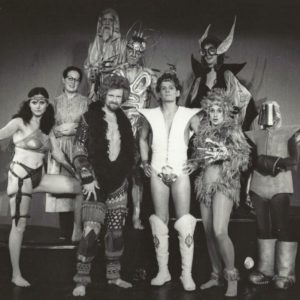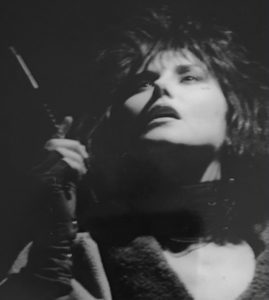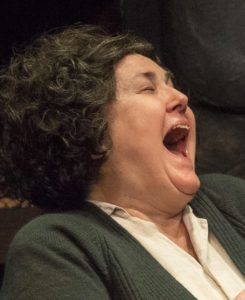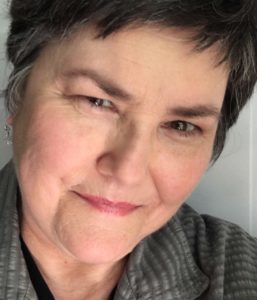Deb Sargent Shaver in “Centaurs” – Courtesy of Phoenix Theatre. Used with permission.
When thinking about how I would preview Kurt Vonnegut’s “God Bless You, Mr. Rosewater,” the debut production, opening May 11, of the brand-new Phoenix Theatre Cultural Center, located at 705 N. Illinois Street in Indianapolis, one person came to mind almost immediately. One of my proudest accomplishments is the role I played as a founding board member of the Phoenix. In 1982, I joined a group of stalwarts to help Bryan Fonseca pursue his vision and mission which continue with this newest chapter in the theatre’s storied history. It was during that time that I first met Deb Sargent Shaver who was in the cast of “WARP!” the Phoenix Theatre’s very first show presented in 1983. We have remained friends ever since. As a reviewer, I have seen a majority o of shows from Shaver’s substantial body of work over the years. And now that she is a cast member of the first production at the new space. I couldn’t think of anyone better suited than Sargent Shaver to provide a perspective of what the new Cultural Center represents. Here is an edited transcript of an interview we did in Irvington (our beloved shared neighborhood) and from email correspondence.
Describe the goodbye to the old church, parade and ribbon cutting at the new Phoenix Cultural Center on April 28.
The goodbye in the old church was fabulous. Everyone sat on the risers with board members on chairs on stage. It was packed. The first thing that happened was Bryan got a standing ovation and then various folks talked, including everyone from the very funny new owner of the building, who talked about what was going to happen to the church, to Patricia Castaneda and Carlos Sosa. They talked about how the Phoenix champions Hispanic artists and audiences and how they met and fell in love doing Phoenix shows. Someone asked me why the founders (Fonseca, Gayle Steigerwald, Suzanne Fleenor or “Suzer”, Chuck Goad and Sargent Shaver) didn’t speak. But we know our stories. We wanted to hear other people’s. Then, we had the parade, which was my favorite part of the day. It was a very large crowd of folk. We walked backwards down Park Avenue to a New Orleans band playing dirge music. Everyone was given rose petals to strew. There were also people holding Phoenix red-and-white umbrellas, red streamers, etc. and at the front of the parade was a huge Phoenix puppet that took five people to hold aloft. When we reached the Cultural Trail down the block, the music became lively and everyone moved forward. Very festive and fun. And the best part was the mix of people. I didn’t know half of them and I thought that was terrific. Babies, kids, young folk, black, white, rich, poor – you name it. For those who didn’t want to walk, there was a trolley and it went back and forth from old to new for several hours. Once we got to the new Phoenix, the mayor, Frank Basile, Bryan and Kevin Kruse (Phoenix executive director) cut the ribbon and everyone went inside for tours and another program. I didn’t see the program because it was packed and I’ve been rehearsing in the building, so didn’t need to see it. After the hoopla – the five founders had photos taken and then we walked down to Olly’s and had tenderloins. The day was better than I could have imagined.
As a founding member of the Phoenix Theatre, what does the new Phoenix Theatre Cultural Center mean to you?
I’m really winding down my career, so the new building is more of a symbol to me. It means that my career as a Phoenix artist helped lead to the building of the new space and that my legacy, in fact, all of our legacies, will continue even after we are no longer on this plane of existence. Because of our contributions, other artists will have a great space to create and grow as artists and will inspire the next generation and so forth. That’s what is important. And somewhere in the next five or so years, we old folk will retire and play cards and share a million stories with each other while the next generation takes the reins.

Deb Sargent Shaver (far left) and the cast of “WARP” – Courtesy of Phoenix Theatre. Used with permission.
When did your history with the Phoenix commence?
Well, my history with the Phoenix started when John Lampson called me when I lived in Ohio. It was kind of fortuitous because I was going through a rough patch in my first marriage. He said there is a great new theater opening up and there’s this great part for you, Sargon Mistress of War in “WARP!, I, II & III”, so I said, “Well, OK,” because the timing was right and then I came to Indy to audition. Here’s some more dirt that you may want to know. I found out, maybe one hour before the audition, that my ex-husband was having an affair with a mutual friend of ours. So, I looked at my friends and said, “I need a drink.” I had a scotch, went to the theater, auditioned and got the part. Then, I moved to Indianapolis to do the show. I was planning on going back to Cincinnati but I bonded with this group, so much so, that I have been here for 35 years now. I have been very fortunate. I have gotten to do…I lost count. It’s like 60 shows and that includes some period of time when I didn’t do anything for years. I am very fortunate because I got to do just about everything I wanted to do. Not everything, but a lot of what I wanted to do. I think I took a break when I met my husband Bill, so we could have some quality time. I had a break when Patrick was born and now I am taking a break because I am older and there is less for me to do.
How has your Phoenix experience impacted you as an artist?

Deb Sargent Shaver in “The Threepenny Opera” 1987 – Courtesy of Phoenix Theatre. Used with permission.
Until the Phoenix, I had never done a brand-new play. And nothing tests an actor like working on something from the ground up. Playwrights often make many changes with new scripts. Marcia Cebulska would experiment with rearranging scenes and adding and subtracting pages. One time, we had already opened “Centaurs” and Bryan called me at work and asked if I could come in a little early. I asked why and he said “Marcia rewrote the ending and you now live!” And Corbin Patrick (the late Indianapolis Theatre critic) was reviewing that night and I had to learn a new monologue and change the focus of my character’s trajectory in just a few hours. Damn. It was hard, but it was great training in being flexible and fast. Thirty-something years later, I no longer have that flexibility, but I did for many years, because of the Phoenix and its commitment to new plays.
What has your friendship with Bryan meant to you?
My friendship with Bryan has been life changing. I only came to town to do “WARP!” and then I was going to move back to Ohio, but I just clicked with Bryan and Chuck and Suzer and the whole gang and never looked back. Bryan and I became instant friends. And then we were roommates for several years. We went on vacations together. He was my “person of honor” at my wedding. I’ve nursed him through several illnesses. We share the same sense of humor and work very well together. But we are also both strong willed and we’ve had a few legendary spats and yet, we work through them and move forward. We work through them because we love each other. I can’t imagine a world without him. I am in awe of Bryan. I’ve never met anyone with his vision and drive and I worked for Mayor Hudnut for five years. I’m the detail person who is always pointing out little things, such as a costume that needs hemming. But Bryan is the big-picture guy. He sees the entire play, the entire theatre, the entire community in his head and works like a madman to make it happen. We would never have started the Phoenix and kept it going for 35 years or built a new Phoenix without his vision and perseverance.
Describe the current space and its amenities compared to the resources available in the old church.

Deb Sargent Shaver in “The Cripple of Inishmaan” 2015 – Courtesy of Phoenix Theatre. Used with permission.
The new space has so much room. The old office was so cramped that some of the staff and interns had to work on TV trays. Now, everybody has their own cubicle in a spacious and well-lit, brand-new room. And the differences in the lobby space and the bathrooms are night and day. The old space was quaint. The new space is a cool destination! Also, you don’t have to search for a parking space. We have a 49-car lot, versus our old eight-car parking lot, and there is plenty of available street parking. And the downtown views are spectacular. Also, we are not very far from Mass Ave. You can park at the new space, walk the Cultural Trail to Mass Ave and have dinner, stroll back and see a show. The two stages are still intimate, but the mainstage has wide seats with plenty of leg room and the risers are taller, so nothing will block your view. I remember in the old space having a tall person sit in front of me and I constantly had to move to see the stage. There is none of that in the new theatre. There is so much leg room that you don’t have to stand when someone walks in front of you. And we have new high-tech lighting equipment, space to fly in scenery and backdrops – all the bells and whistles that we never had before.
Tell me about “God Bless you, Mr. Rosewater,” the first show at the Phoenix’s new space.
I can’t really describe “Mr. Rosewater” in just a couple of sentences. If you are a fan of Kurt Vonnegut, you’ll understand why. There are some crazy turns in the story, from an alien appearing in a restaurant to volunteer firefighters doing a soft-shoe routine. But the basic story is about money. Having it and not having it. This story is as timeless today as it was when Vonnegut wrote it in the 60s, maybe even more so. And it’s a musical that’s set in Indiana, based on a novel by a native son, Vonnegut, who worked on the original musical in New York and it’s never been done in Indiana. How many more reasons do you need?
What’s it feel like having been in the Phoenix’s very first show and now in its first on its new mainstage?I’ll tell you the difference between being in the first play 35 years ago and doing the first play now – energy level —Suzer, Chuck and I are all now in the 63-year-old range and rehearsing until 10:15 at night, which is past our bedtime.
For tickets and information about “God Bless You, Mr. Rosewater” call the Phoenix Theatre box office at (317) 635-7529 or visit phoenixtheatre.org.






